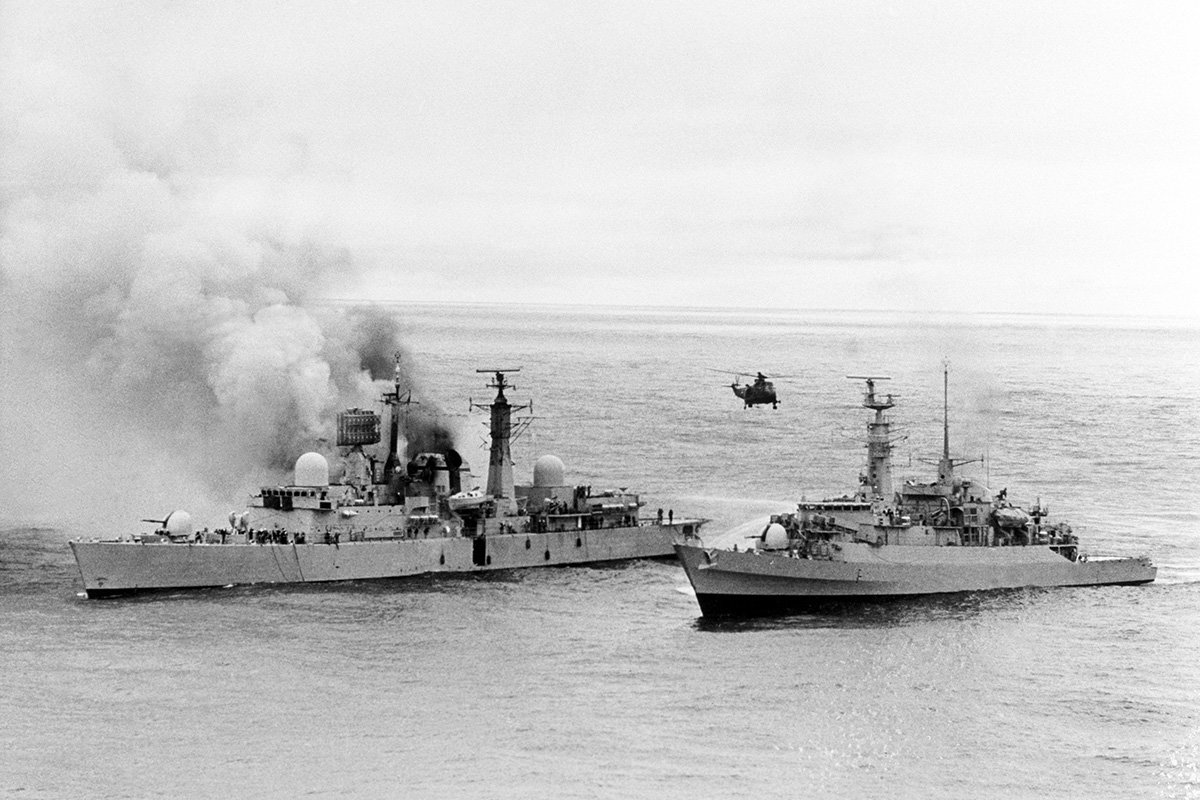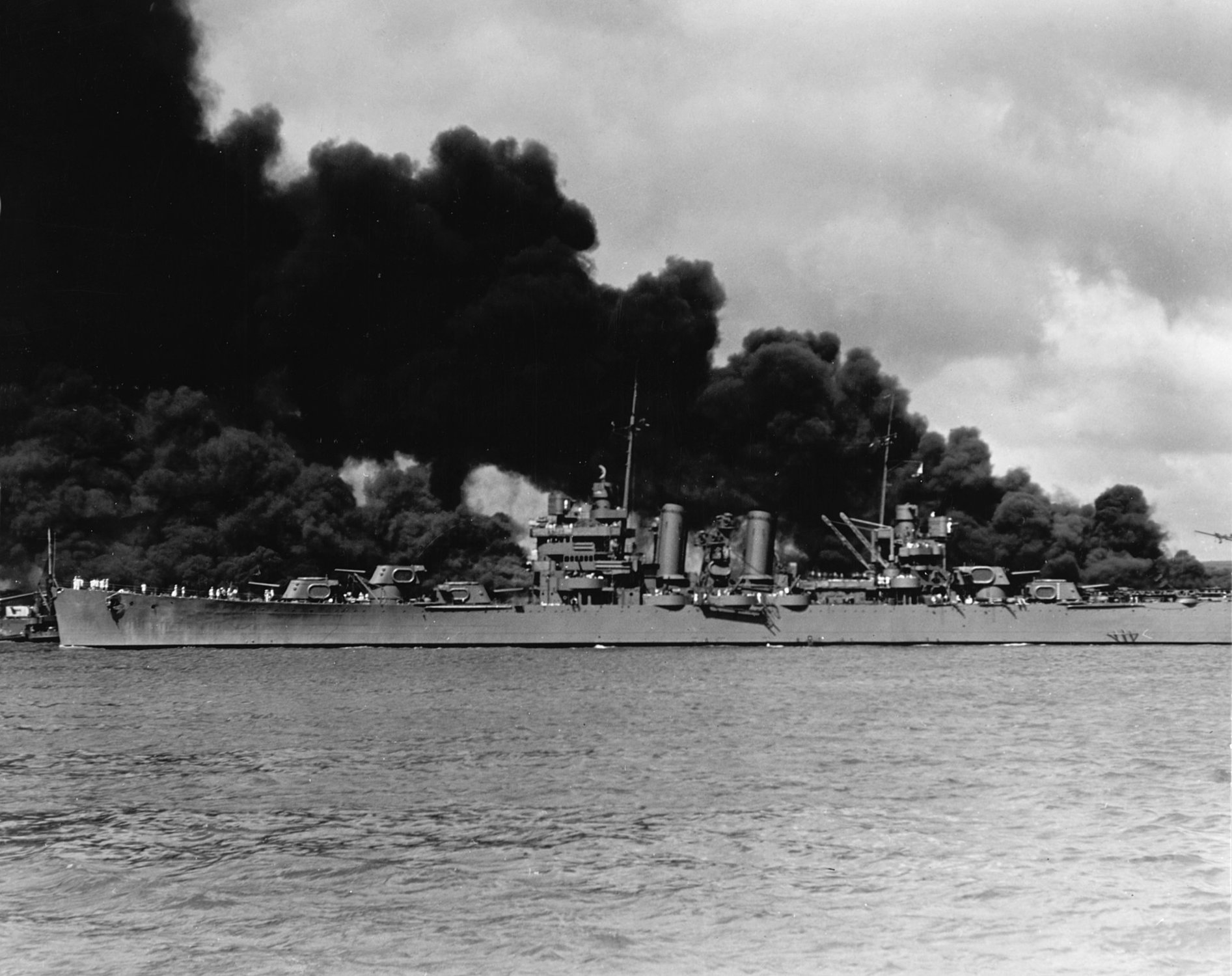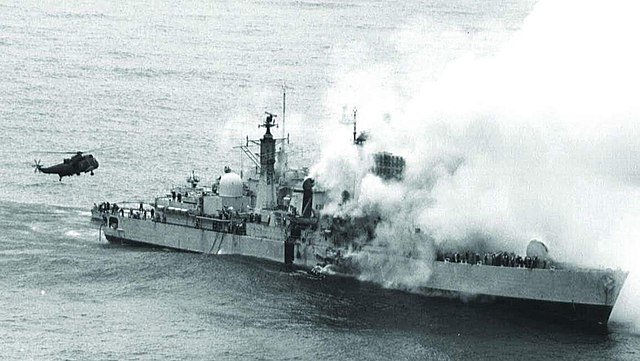The Last 2 Major Warships Sunk in Battle Were in the 1982 Falklands War

The HMS Sheffield on fire after the battleship was hit by a missile during the 1982 Falklands War. Alamy stock photo.
When the Russian missile cruiser Moskva sank on Thursday, April 14, hit by two anti-ship missiles, it was the largest warship lost at sea since World War II, and the first major surface combatant ship sunk since the Falklands War in 1982. During that conflict, in the span of just two days, the Argentine and British navies each sank one of its opponent’s major warships. On May 2, 1982, a British submarine sank the ARA General Belgrano, a massive but aging destroyer nearly as big as the Moskva. Two days later, an Argentine aircraft fired an Exocet missile at the HMS Sheffield, crippling the destroyer. Abandoned, it sank less than a week later while being towed.
A month before the two sinkings, Argentina had invaded the Falkland Islands, a long-disputed, overseas, British-held territory located off the southern tip of South America. For centuries, the two nations had contested ownership of the Falkland Islands. In 1832, after the Argentines seized US ships in the area, the USS Lexington destroyed the lone Argentine fort built on East Falkland. A year later, a British force expelled the remaining Argentine officials on the islands and, by 1892, had established an official British colony. Argentine diplomats fought to regain control, but in a 1981 referendum, the Falkland Islanders voted to remain British. Argentina’s military junta launched a full-scale invasion of the islands in April 1982.
The 74-day conflict ultimately led to the deaths of three islanders, 649 Argentines — almost half of whom died on the General Belgrano — and 255 British military personnel, including 20 from the HMS Sheffield.
ARA General Belgrano
The General Belgrano was no stranger to combat or sinking ships. Prior to service with the Argentine navy, it had served in the US Navy as the USS Phoenix and was moored at Pearl Harbor on Dec. 7, 1941. Unscathed in the attack by Japanese warplanes that sank larger battleships anchored nearby, the Phoenix’s guns fired on retreating Japanese aircraft. Later in the war, during the Pacific campaign, it faced repeated kamikaze attacks, its guns shooting one down just 100 yards before it would have impacted.

After World War II, the ship was decommissioned and sold to Argentina in 1951, where it was eventually renamed the General Belgrano.
In 1982, the ship was at the center of a task force when it was hit with two torpedos by the submarine HMS Conquerer. It sank hours later, with 772 of the crew eventually rescued and 323 killed.
HMS Sheffield
Two days later, on May 4, 1982, a flight of two Argentine Super Etendard fighters — French aircraft similar to American F-4s — took off carrying anti-ship Exocet missiles.
Survivors from the Sheffield have since recounted the shocking loss over the years, including on the 40th anniversary of the battle.
Andy Stephenson, an 18-year-old sailor assigned to the logistics staff aboard the HMS Sheffield, told the BBC years later that the Type 42 destroyer had been tasked with protecting the HMS Hermes aircraft carrier. The sailor had experienced incoming missile fire once before, but allied aircraft had intercepted the threat.
“At action stations on a warship you are getting a running commentary from the captain on the bridge. ‘Missile released coming toward us… 50…40…30 miles,’” Stephenson told the BBC. “And you tense up but then one of our Seaharrier planes took out the missile and you carry on as normal.”
When the Exocets hit, the attack was like “hell and fury,” Stephenson said.
“There was an almighty blow-out and then I was sucked back into the mess, I heard no bang,” he said. “I came to, didn’t know what happened but the mess door was blown off.”
The bulkhead doors were open, and thick black smoke billowed into the mess hall. He regained his composure and slowly moved to reach an upper deck, where he and others found a massive burning hole in the side of the ship where the missile had hit.

Declassified reports from 2006 published in The Guardian revealed British officers on the bridge had been “mesmerized” by the sight of the incoming missile and failed to raise the alarm.
The board overseeing the after-action review to uncover what had gone wrong determined that Sheffield’s captain, a submariner named Sam Salt, and his second-in-command, a helicopter officer, had “little or no relevant recent surface ship experience. The destroyer didn’t activate “action stations,” so the missile strike had caught many sailors on the ship, including Stephenson, off guard.
Despite the Argentine military having only five Exocet missiles in its arsenal, Prime Minister Margaret Thatcher ordered a special forces mission to seize the Argentine air base that housed the aircraft that carried the missiles. The British Special Air Service received orders to sabotage the missiles and the fighter aircraft that carried them. However, poor weather grounded the special forces team and eventually scrubbed the operation.
Although the HMS Sheffield didn’t sink immediately, the surviving sailors parted ways in a truly British fashion. As they awaited rescue, the sailors joined arms and were led by submarine Lt. Carrington-Wood in singing “Always Look on the Bright Side of Life” from Monty Python’s Life of Brian movie.
Read Next:

Matt Fratus is a history staff writer for Coffee or Die. He prides himself on uncovering the most fascinating tales of history by sharing them through any means of engaging storytelling. He writes for his micro-blog @LateNightHistory on Instagram, where he shares the story behind the image. He is also the host of the Late Night History podcast. When not writing about history, Matt enjoys volunteering for One More Wave and rooting for Boston sports teams.
BRCC and Bad Moon Print Press team up for an exclusive, limited-edition T-shirt design!
BRCC partners with Team Room Design for an exclusive T-shirt release!
Thirty Seconds Out has partnered with BRCC for an exclusive shirt design invoking the God of Winter.
Lucas O'Hara of Grizzly Forge has teamed up with BRCC for a badass, exclusive Shirt Club T-shirt design featuring his most popular knife and tiomahawk.
Coffee or Die sits down with one of the graphic designers behind Black Rifle Coffee's signature look and vibe.
Biden will award the Medal of Honor to a Vietnam War Army helicopter pilot who risked his life to save a reconnaissance team from almost certain death.
Ever wonder how much Jack Mandaville would f*ck sh*t up if he went back in time? The American Revolution didn't even see him coming.
A nearly 200-year-old West Point time capsule that at first appeared to yield little more than dust contains hidden treasure, the US Military Academy said.












